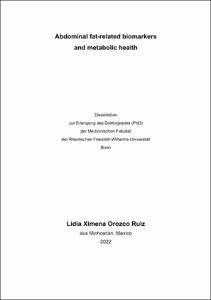Orozco Ruiz, Lidia Ximena: Abdominal fat-related biomarkers and metabolic health. - Bonn, 2022. - Dissertation, Rheinische Friedrich-Wilhelms-Universität Bonn.
Online-Ausgabe in bonndoc: https://nbn-resolving.org/urn:nbn:de:hbz:5-67697
Online-Ausgabe in bonndoc: https://nbn-resolving.org/urn:nbn:de:hbz:5-67697
@phdthesis{handle:20.500.11811/10183,
urn: https://nbn-resolving.org/urn:nbn:de:hbz:5-67697,
author = {{Lidia Ximena Orozco Ruiz}},
title = {Abdominal fat-related biomarkers and metabolic health},
school = {Rheinische Friedrich-Wilhelms-Universität Bonn},
year = 2022,
month = aug,
note = {Obesity is considered one of the major risk factors for chronic diseases and mortality. Although body mass index (BMI) is generally used to classify obesity, BMI can lead to the misclassification of individuals at cardiometabolic risk. Some individuals with a high BMI actually have a low cardiovascular disease (CVD) risk. The limited suitability of BMI for risk classification is due to the lack of information regarding body fat distribution, particularly abdominal fat. Beyond BMI, other anthropometric measurements such as waist circumference (WC), waist to hip ratio (WHR), and waist to height ratio (WHtR) are commonly used as proxies for abdominal fat. However, also their associations with cardiometabolic risk and thus validity as risk markers remain questionable. Abdominal fat consists of visceral and subcutaneous adipose tissue (VAT and SAT), two metabolically different fat compartments. However, the relationships of VAT and SAT with cardiometabolic risks are rather complex and not yet completely understood. In this thesis, I aimed to investigate the association of abdominal fat, as assessed through anthropometric and abdominal MRI measurements, with cardiometabolic risk markers of metabolic health. To enable this, I first collaborated with experts of artificial intelligence in medical imaging, and targeted metabolomics analysis, to develop the measures to be used (fat segmentation; metabolic profiling). Next, I investigated the interplay of abdominal fat-related biomarkers and metabolic health. The analyses were based on the first 5000 participants from the baseline examination of the Rhineland Study. My main findings are 4-fold. First, I confirmed that larger VAT volumes are more metabolically detrimental than SAT in women, whereas VAT and SAT are associated with cardiometabolic risk markers to a similar extent in men. Second, I observed that among anthropometric measurements, WC is the best surrogate marker for VAT. However, none of the anthropometric measurements added further information on cardiometabolic risk markers above that offered by VAT alone, suggesting that abdominal MRI measurements cannot be replaced if we want to understand underlying mechanisms linking adiposity and metabolic diseases. Third, I found that larger VAT volume in metabolically unhealthy persons might alter the metabolism of branched-chain (BCAA) and aromatic amino acids (AAA). And lastly, my research suggests that BCAA and AAA downstream metabolites might be involved in the mechanisms that underlie the relationship of abdominal VAT with metabolic health.},
url = {https://hdl.handle.net/20.500.11811/10183}
}
urn: https://nbn-resolving.org/urn:nbn:de:hbz:5-67697,
author = {{Lidia Ximena Orozco Ruiz}},
title = {Abdominal fat-related biomarkers and metabolic health},
school = {Rheinische Friedrich-Wilhelms-Universität Bonn},
year = 2022,
month = aug,
note = {Obesity is considered one of the major risk factors for chronic diseases and mortality. Although body mass index (BMI) is generally used to classify obesity, BMI can lead to the misclassification of individuals at cardiometabolic risk. Some individuals with a high BMI actually have a low cardiovascular disease (CVD) risk. The limited suitability of BMI for risk classification is due to the lack of information regarding body fat distribution, particularly abdominal fat. Beyond BMI, other anthropometric measurements such as waist circumference (WC), waist to hip ratio (WHR), and waist to height ratio (WHtR) are commonly used as proxies for abdominal fat. However, also their associations with cardiometabolic risk and thus validity as risk markers remain questionable. Abdominal fat consists of visceral and subcutaneous adipose tissue (VAT and SAT), two metabolically different fat compartments. However, the relationships of VAT and SAT with cardiometabolic risks are rather complex and not yet completely understood. In this thesis, I aimed to investigate the association of abdominal fat, as assessed through anthropometric and abdominal MRI measurements, with cardiometabolic risk markers of metabolic health. To enable this, I first collaborated with experts of artificial intelligence in medical imaging, and targeted metabolomics analysis, to develop the measures to be used (fat segmentation; metabolic profiling). Next, I investigated the interplay of abdominal fat-related biomarkers and metabolic health. The analyses were based on the first 5000 participants from the baseline examination of the Rhineland Study. My main findings are 4-fold. First, I confirmed that larger VAT volumes are more metabolically detrimental than SAT in women, whereas VAT and SAT are associated with cardiometabolic risk markers to a similar extent in men. Second, I observed that among anthropometric measurements, WC is the best surrogate marker for VAT. However, none of the anthropometric measurements added further information on cardiometabolic risk markers above that offered by VAT alone, suggesting that abdominal MRI measurements cannot be replaced if we want to understand underlying mechanisms linking adiposity and metabolic diseases. Third, I found that larger VAT volume in metabolically unhealthy persons might alter the metabolism of branched-chain (BCAA) and aromatic amino acids (AAA). And lastly, my research suggests that BCAA and AAA downstream metabolites might be involved in the mechanisms that underlie the relationship of abdominal VAT with metabolic health.},
url = {https://hdl.handle.net/20.500.11811/10183}
}






